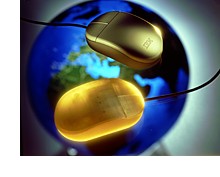|
Logitech
 The World Leader in Senseware™ Orchestrates a Sales Tour de Force Using
Solid Imaging
The World Leader in Senseware™ Orchestrates a Sales Tour de Force Using
Solid Imaging
Logitech, the world's largest maker of computer mice and a market leader in imaging technology, is tapping the power of solid imaging for product packaging. In the fiercely competitive computer industry, products proliferate and commodity pricing reigns supreme. The ability to reduce time-to-market by creating new product designs at hyperspeed is a coveted advantage in building market superiority. Logitech is quickly mastering the use of prototypes to win new business.
A dream come true: A blue-chip computer company approaches Logitech, the world's largest manufacturer of pointing devices and a market leader in imaging technology, to request a quote on a unique two-button mouse. Only one hitch. The quote package was due for the sales presentation by February 6. It was already January 21. That meant design to finished prototype in less than two weeks. What a coup, if they could do it: Production units were scheduled for rollout in six months.
A formidable competitor and a timetable that would forgive no mistakes - a recipe for anxiety. Strategically important as a customer, this was a must-win quote. In true Logitech form, the motto was "seize the day."
They decided: Why not walk into the presentation armed with prototypes to be put square in the palms of the real decision-makers? Logitech's OEM sales team turned to Rick Lutzinger, director of mechanical engineer, an "advocate of concurrent engineering,", who teamed up with his best designers to get the job done.
From Quote to Prototype in Seven Days
Three days later, with control drawings in hand, David McVicar, senior mechanical engineer and Vance Prather, stereolithography (SL) specialist, set out to build the mice on Logitech's Stereolithography Apparatus (SLA 250). To hold onto their competitive edge, they agreed to keep the prototypes a strategic secret until the big day.
Using ARIES Concept Solids for CAD, the team worked non-stop to construct the sleek mouse case top and bottom, and to engineer the tricky, intricate button geometry. Total time from request for quote to finished part: Seven working days!
"We worked round-the-clock to do something others thought couldn't be
done - three mice in one week. We did it working all night. At one point,
we just sat around staring at parts - we felt good about the results,"
Vance Prather says with a smile in his voice.
The Big Day
After long days filled with anticipation, the quote was ready. Logitech's team returned to the prospect with functional prototypes in hand. And the customer's reaction was "disbelief." Part quality was so superior, says Logitech, that the computer giant awarded the contract on the spot. Today, Logitech ships over one million units per year of this snappy little mouse.
SLA Models "Clinch the Business"
It's thought that Logitech's SLA 250 has paid for itself with this one contract. In addition, the company has shrunk the product cycle from 12 to 6 months.
Better yet, the team is revved up for the infinite possibilities of winning more bids with prototypes. "That model helped us clinch the business and beat a good competitor," confirms Spencer Johnson, OEM sales support manager. "We're now integrating SLA models into our development strategy with customers. It will figure prominently in the future to win business from existing and new customers. SL allows us to be more proactive in building strategic partnerships with customers."
Logitech's nature is to be strikingly proactive. The company has earned an award-winning reputation for high-quality, high-impact industrial design. Its ergonomic Senseware™ product line transforms sight, sound and touch into humanistic tools for computing power. Its wildly popular products with fun, catchy names pack retail shelves internationally, including MouseMan®, ScanMan®, AudioMan™, and Kidz™ Mouse. And OEM penetration spans eight of ten major computer leaders worldwide. Opportunities to win quotes with prototypes are plentiful.
In the past 33 months, since implementing SL, Vance Prather has built nearly 1,000 parts. He declares that "it's a common practice now to include parts in a quote. If a customer needs an OEM peripheral in the negotiation stage, they get it." Logitech's own service bureau has been so successful at serving up parts to hungry departments that it's running a 30-day backlog.
Logitech's retail product team conducts focus groups many times a year to test the ergonomics of their designs with real users. Before solid imaging, they had to use foam models that were not very precise. "Now, we get better feedback because the parts are more tactile," explains Spencer Johnson.
An International Tool to Protect Market Share
A spirit of achievement propels this energetic company. In barely ten years, Logitech grew to be a global pacesetter with revenues over $200 million. Truly international, Logitech management is an exciting blend of European, Asian and American talent. Manufacturing is done at headquarters in Fremont, California, and in Ireland, Taiwan, and China. Dozens of sales offices dot the globe to give customers local service.
The slightest edge can sway the stakes in the sporty game of computer sales. Maybe that's why Spencer Johnson views the SLA as an "international tool to protect and grow market share."
No Time to Rest
The two-button mouse victory is the first example of Logitech's campaign to win quotes with prototypes. Like its Senseware™ products, Logitech never stops evolving. Another big OEM quote is in the pipeline for a whole new design on a trackball device. If successful," beams Spencer Johnson, "the win will put us into a new product and new market avenue."
Is there any doubt of victory?
|



